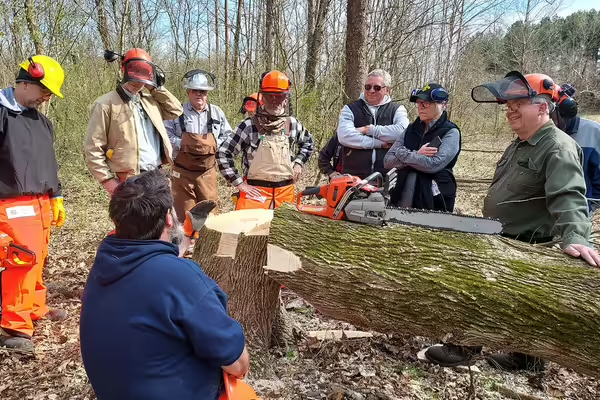
SIMPSON, Ill. — To understand tree and forest care often requires getting to the root of the matter. The Beginning Forest Landowner Program is returning in 2024-25 to help more Illinois forest owners learn how to manage their woodlands.
Buying and maintaining forested land can be intimidating, but the University of Illinois Extension Forestry team works with landowners to build the skills and confidence they need to maintain healthy forests and achieve their goals. Now in its third year, the Beginning Forest Landowner program coordinated by Forestry Extension and Research Specialist Chris Evans has already helped several dozen landowners become better stewards of their forests and learn about forest ecology, tree identification, the timber harvesting process, thinning and pruning, managing for wildlife, invasive species control, prescribed burning, and more.
“Before the program, I didn’t really address [my forest] because I didn’t really know [best practices]. That was the whole idea behind joining this. It was an opportunity to gather more knowledge and continue to make improvements. We went through so many classes with information that I never would have received if I wasn’t in the program,” said Aaron Jackson, a previous program participant.
The 2024-25 program will be on the weekends of Oct. 4, Nov. 8, Jan. 10, and Feb. 7 at Dixon Springs Agricultural Center, 354 State Highway 145N, Simpson. The course starts at 9 a.m. on Friday. Each weekend will include class presentations, hands-on practices, and field tours. The course also includes webinar presentations on timber taxes, forest management for wildlife, online resources for landowners, and agroforestry. Participants are also invited to a forestry Maple Syrup Production Workshop on Feb. 1.
The program cost is $50, and the course is limited to 30 participants. Priority is given to applicants who purchased a forested property in the last 10 years, forest owners who are new to management, and those who own land in Southern Illinois. The cost includes a course guide, a tree identification book, and several forestry tools and safety gear. Lodging options are available during the weekend courses at Dixon Springs for an additional fee.
Register by Oct. 1. Learn more and sign up at go.illinois.edu/BFL.
For questions about the program, or to request a reasonable accommodation to participate, please contact Evans at cwevans@illinois.edu. Early requests are strongly encouraged to allow sufficient time for meeting your access needs.
A three-year grant from the USDA’s Beginning Farmer and Rancher Development Program supports this program, which is a collaboration between Illinois Extension Forestry and the Illinois Forestry Association, Illinois Department of Natural Resources Division of Forestry, Shawnee Resource Conservation & Development Area, Nature Conservancy, Southern Illinois Prescribed Burn Association, and River to River Cooperative Weed Management Area.
The Extension Forestry program provides forestry and natural resources education, technical assistance, programming, and awareness to a diverse audience, including an estimated 132,000 private forest landowners who own 3.7 million acres or 82% of all forest land in Illinois. Find more about the program at go.illinois.edu/Forestry.
University of Illinois Extension develops educational programs, extends knowledge, and builds partnerships to support people, communities, and their environments as part of the state's land-grant institution. Extension serves as the leading public outreach effort for University of Illinois Urbana-Champaign and the College of Agricultural, Consumer and Environmental Sciences in all 102 Illinois counties through a network of 27 multi-county units and over 700 staff statewide. Extension’s mission is responsive to eight strategic priorities—community, economy, environment, food and agriculture, health, partnerships, technology and discovery, and workforce excellence — that are served through six program areas — 4-H youth development, agriculture and agribusiness, community and economic development, family and consumer science, integrated health disparities, and natural resources, environment, and energy.